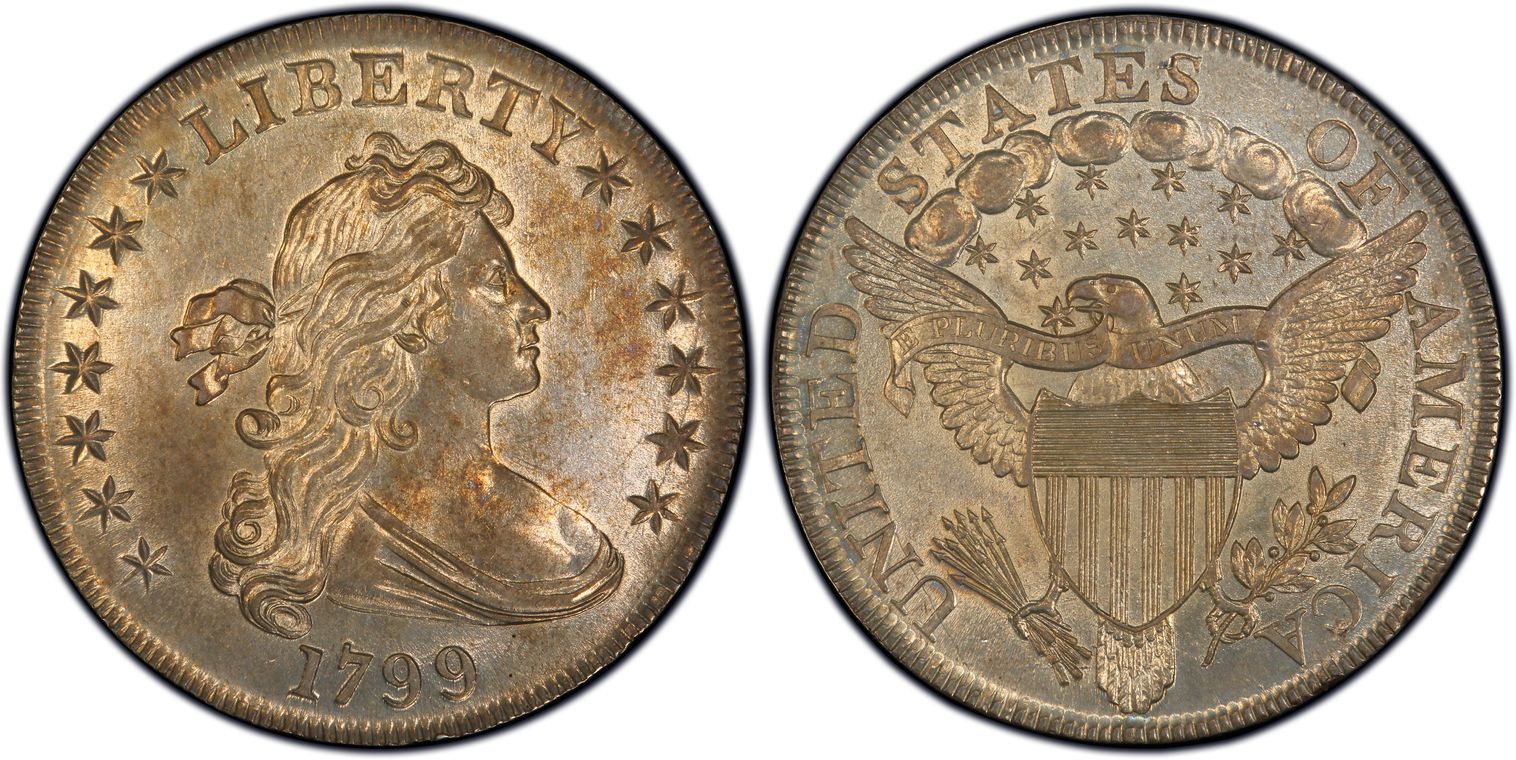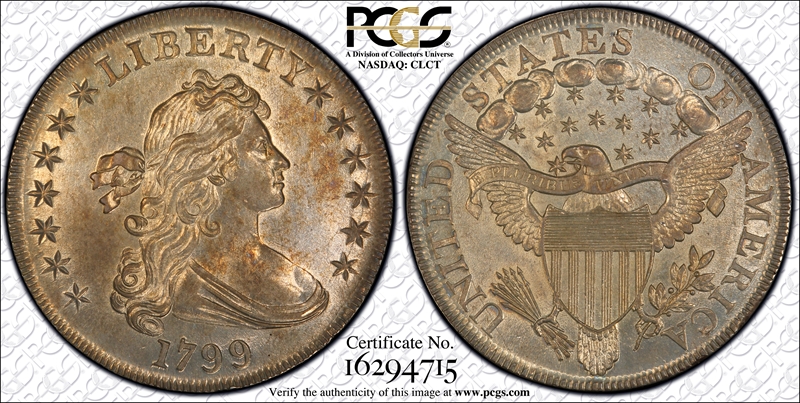1799 $1 BB-164 MS62 认证号16294715, PCGS号40055
拥有者评论
B-17, BB-164 1799 WOW! Try to find a nicer MS Early Dollar. Golden rich toning and an magnificent strike. R2. Est.Pop. 500-750 coins. In top CC.(Probably #1). Should be MS 65!
专家评论
Q. David Bowers
The following narrative, with minor editing, is from my "Silver Dollars & Trade Dollars of the United States: A Complete Encyclopedia" (Wolfeboro, NH: Bowers and Merena Galleries, Inc., 1993). Note: the Notable Specimens list should be used with caution - it has been updated in my 2013 edition of "The Encyclopedia of United States Silver Dollars 1794-1804."Bolender 17, Haseltine 7
OBVERSE 4: See description under 1799 BB-156. Although this obverse die was used to coin BB-156, BB-157, BB-161, BB-162, BB-163, and BB-164, in its use with BB-164, the state is most similar to BB-163, with the "pocket" or "cobweb" (die clash mark) at junction of chin and neck removed by relapping the die. A die crack shows through last 4 stars. A faint crack is near border opposite point of bust. All seen are weak at the centers, especially on the obverse.
Obverse die used to strike 1799 BB-156 (with clash marks), BB-157, BB-161 (now relapped), BB-162, BB-163, and BB-164.
REVERSE L: Five extremely large berries in olive branch, the largest on any 1799 dollar. The two upper berries are partly buried in the leaves. Point of star enters eagle's mouth, upper part of beak closing down on star. The point of the star almost touches lower part of beak; ray points to left edge of left serif of U in PLURIBUS. Leaf points near left corner of I in AMERICA. A does not touch feathers. Very short stem in claw; shortest stem on any 1799 reverse. Peculiar raised die flaws resembling an equal sign (=) are at an angle under the star that straddles clouds 2 and 3. An incuse die mark at the upper left corner of the leftmost cloud is present on the early die state; the second S in STATES is repunched at the inside of its lower loop. Far right edge of A is over junction of clouds 3 and 4. The letters in E PLURIBUS UNUM seem larger and in some instances differently proportioned on this reverse (and also on BB-162, a different die), in comparison to the other reverses of the year.
Reverse die used to strike 1799 BB-164 only.
DIE STATES:
Die State I: Obverse die with crack from stars 10-13 to drapery, plus tiny, lower crack from drapery end extending right about 2/3 the way to star 13. Reverse with no cracks. No more than 5% of surviving BB-164 dollars are of this die state.
Die State II: Obverse as preceding. Reverse with hairline crack beginning from right side of U, through bottom of N, extending (in two or three intermediate states) to bottom of Scarce die state.
Die State III: Bolender-17a. Obverse as preceding. Reverse with crack from border, then through UNITED as in Die State II, continuing though eagle's wing, then (in at least two intermediate states) to S, then to left arm of T. Many seen.
Die State IV: Obverse as preceding. Reverse with crack now continuing past ST to top of A to border. Crack from bottom of S, above clouds, to OF. Crack develops at border and goes part way through space between I and C of AMERICA, then in an intermediate state, continues across branch and into right side of shield. Small cracks develop to the left of first A in AMERICA and to the right of right ribbon loop near end. Scarce die state.
Die State V: Obverse as preceding. Reverse with crack from rim at bottom through the eagle's tail to the arrow feathers. Not seen. The description of Gilhousen (Superior, 1973):1261 mentions the Philip Straus coin was the first of this die state reported; now possibly 8 to 12 are known. Gilhousen's (Ostheimer's) was VF-35.
COLLECTING NOTES: As an estimated 550 to 950 specimens of the 1799 BB-164 dollar are known, examples are readily available on the market. Most are in grades through EF. AU coins are somewhat more elusive than the overall rarity might suggest. Mint State coins are great rarities.
NOTABLE SPECIMENS:
Davis Specimen. MS-60. Stack's, Davis-Graves (James Davis) Collection, 1954:1307. "Well struck and lustrous. Unc."
Stack's March Sale Specimen. MS-60. Stack's, 1983:935. "Brilliant Unc., some faint friction and a few hairlines. Full frosty mint bloom with a satiny surface. Magnificent pink and iridescent toning."
Schuyler Specimen. MS-60. Schuyler Collection . M.H. Bolender Collection. - Lester Merkin, AJ. Ostheimer, 3rd Collection, 1968:289. "Unc., magnificent prooflike surfaces; faint obverse cabinet friction. Reverse superior and with full breast feathers, though weak at parts of r. wing as usual. Beautiful iridescent toning. Light reverse adjustment marks."
Essex Institute Specimen. MS-60. Stack's, Essex Institute Collection, 1975:992. "Brilllant Unc., frosty mint bloom displaying the unusual 'cartwheel' effect. The reverse stronger than the obverse. Pale golden and iridescent toning."
Johnson Specimen. AU-58. B. G. Johnson, who probably obtained it from the Brand estate. New Netherlands 48th Sale, T.James Clarke Collection, 1956:637. "Reverse die cracked clearly from border through UNITED, left wing, up through ST. An additional crack, among others, at the base of ATES. Not quite full Unc. Fairly well struck and centered, the reverse border denticles extra bold. A very few infinitesimal obverse marks; a touch of reverse cabinet friction upon eagle's head. Two tiny planchet defects in the reverse border. Spots of luster; iridescent golden, pale violet, and steel gray color."
New Netherlands 53rd Sale Specimen. AU-58. New Netherlands 53rd Sale, June 1959:1208. "Very close to full Mint State; full lustre, now overlaid with interesting obverse toning. Full sharpness save for trifling rubbing on ribbon and
beak (cabinet friction); presumably never in circulation."
Capitol City Sale Specimen. AU-55. Mid American, Capitol City Sale, 1985:687. "A very rare late die state, with an unlisted die break between the I and C of AMERICA. The strike is unbelievably sharp, with full hair and feather details visible. The deep steel-blue and lavender toning is completely natural and very attractive."
Gross Specimen. AU-53. Heritage sale, 1988, Lot 956. Sold to the following. Yolanda Gross Collection.
PCGS #
40055
设计师
Robert Scot
边缘
Lettered: HUNDRED CENTS ONE DOLLAR OR UNIT
直径
40.00 毫米
重量
27.00 克
铸币数量
423515
金属成分
90% Silver, 10% Copper
更高评级数量
1
评级较低的钱币数量
24
地区
The United States of America
价格指南
PCGS 数量报告
拍卖 - PCGS 评级的
拍卖 - NGC 评级的
























